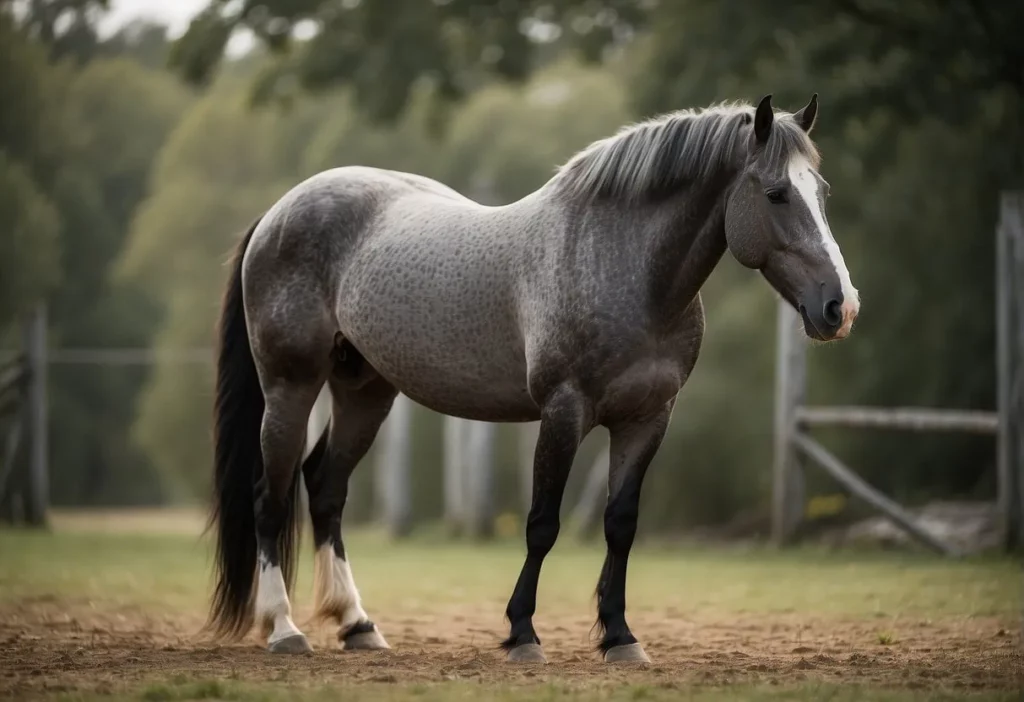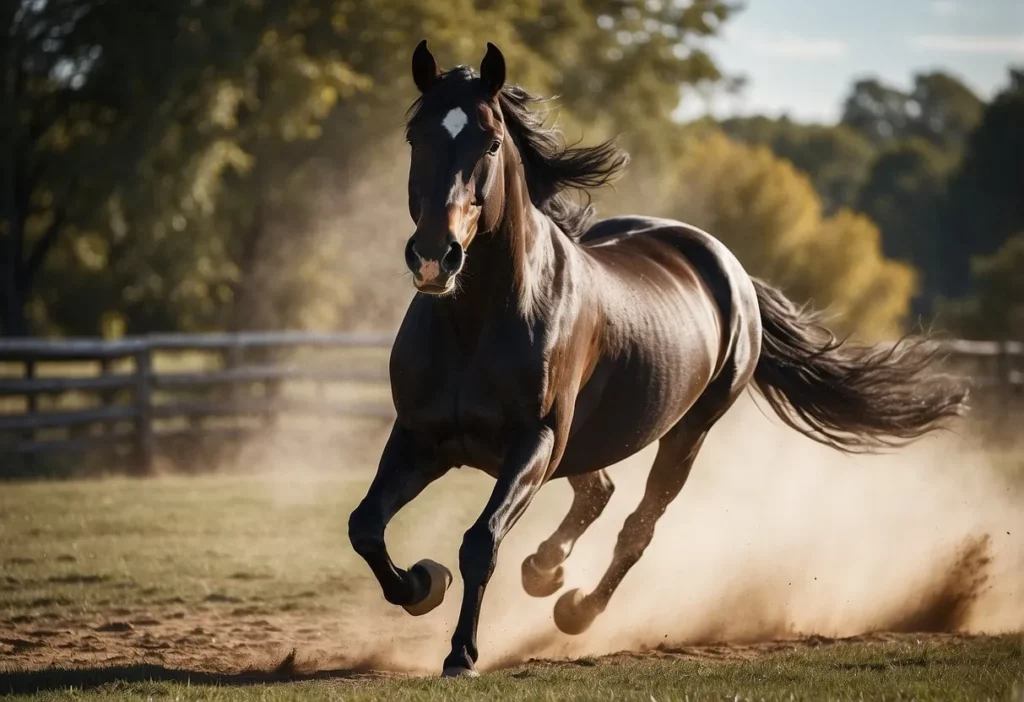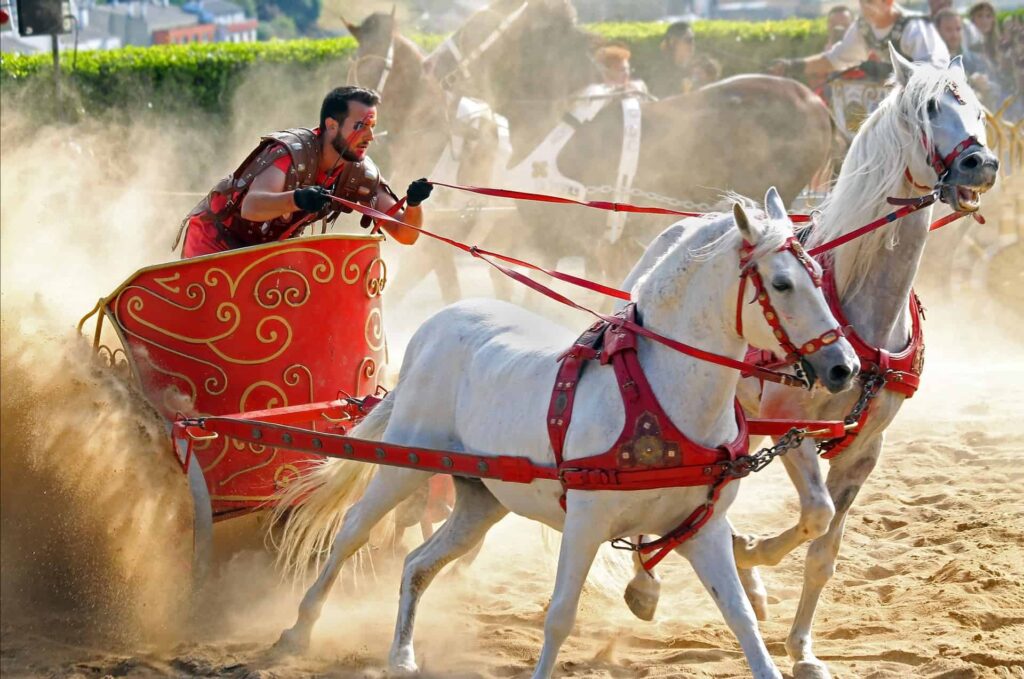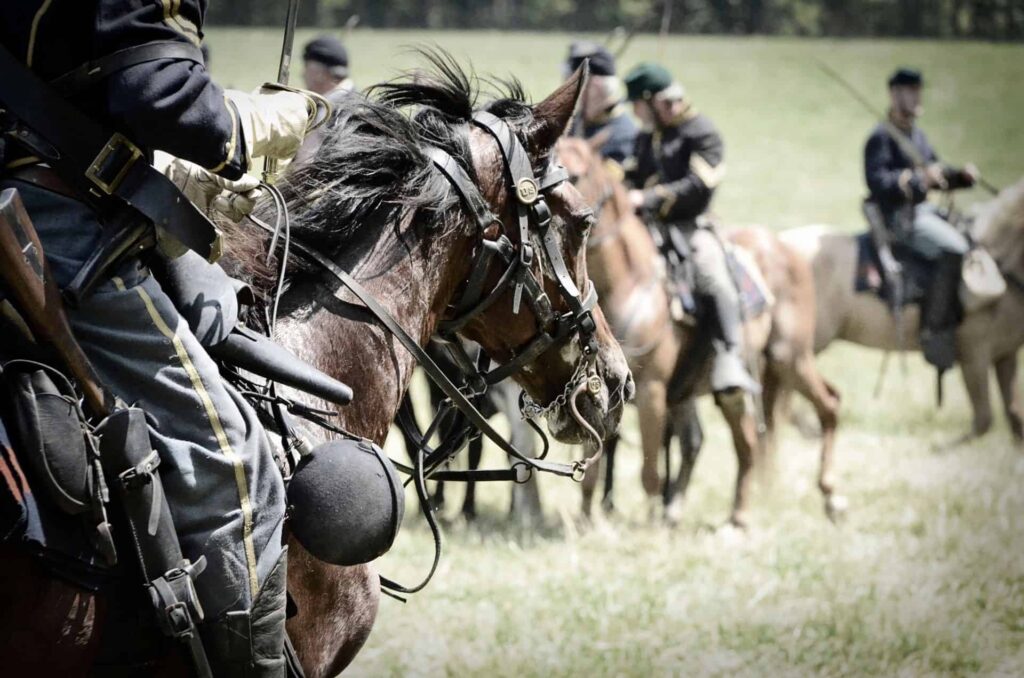Marengo, the famed grey Arabian stallion, stands out for its considerable historical importance due to his close association with Napoleon Bonaparte. Named after the Battle of Marengo, this famous war horse carried the French emperor through several significant military campaigns.
Marengo’s characteristics, including his small stature, significant endurance, and resilience, were highly valued. His ability to survive through numerous battles, while often being wounded, only added to his legendary status and reflected the qualities much admired in military horses of the time.
Despite being a singular creature, Marengo arguably had an impact that reached far beyond his role as Napoleon’s steed. His stories have rippled through culture and history, turning him into a symbol of the Napoleonic era.
This horse’s life intersected with broader themes of bravery, the spoils and sacrifices of war, and the bond between a leader and his loyal companion. Even after his death, Marengo continues to be a subject of interest, not only for individuals fascinated by history but also for educators and conservationists concerned with the restoration and preservation of such prominent historical artifacts.
Key Takeaways
- Marengo was a notable Arabian horse known for carrying Napoleon in key battles.
- The stallion’s resilience and endurance have left a lasting cultural impact.
- Marengo’s story is preserved through educational, scientific, and restoration efforts.
Historical Significance
Marengo was not only a remarkable horse but also a symbol of military power and strategy, closely associated with key Napoleonic battles and representing the strength of cavalry in early 19th-century warfare.
Role in Napoleon’s Campaigns
Marengo, the famed steed of Napoleon Bonaparte, served as a remarkable figure in the French cavalry. This steed carried the French Emperor through numerous military campaigns, epitomizing the critical role of cavalry units in the era’s warfare.
Marengo was known for its endurance and reliability, traits that underscored the Napoleonic war efforts across Europe.
Battle of Marengo
The Battle of Marengo marked a decisive victory for Napoleon, solidifying his status as a military tactician. Conducted on June 14, 1800, it was in this conflict where Marengo gained its name, having carried Napoleon throughout the engagement. The success at Marengo helped secure French dominance in Italy, bolstering Napoleon’s reputation as a commander.
Battle of Waterloo
Contrasting with the triumph at Marengo, the Battle of Waterloo stands as a pivotal moment in history as it led to Napoleon’s downfall. On June 18, 1815, Marengo is believed to have been present as the French faced the coalition led by the Duke of Wellington. Ultimately, this battle resulted in the French defeat, ending Napoleon’s reign and reshaping European political landscapes.
Marengo’s Characteristics

Marengo, the famed horse of Napoleon Bonaparte, boasted distinctive features that were widely recognized and admired. His physical build and lineage are key facets that contribute to his historical and cultural significance.
Physical Description
Marengo was renowned for his gray coat and striking appearance, which set him apart from other horses of his time. Standing at a modest height, Marengo’s skeletal structure displayed the elegance typical of an Arabian stallion.
His head was finely shaped with a broad forehead, large eyes, and small ears, indicative of his breed’s characteristics. The legs of Marengo were well-proportioned, showcasing the strength required for both endurance and agility, while his hooves were tough, and suitable for varied terrains.
| Feature | Description |
|---|---|
| Coat Color | Gray |
| Height | Average for Arabian stallions |
| Head | Fine shape, broad forehead, large eyes |
| Legs | Well-proportioned, strong |
| Hooves | Sturdy and adapted for different terrains |
Breed and Lineage
Marengo was an Arabian breed, a lineage known for producing some of the finest horses in history. Arabian horses are highly valued for their stamina, spirit, and intelligence, traits that Marengo likely inherited.
They have significantly influenced many other breeds, including Thoroughbreds. The ancestry of these horses traces back to the Arabs, who bred them in the harsh desert conditions, where only the strongest survived. This lineage contributed to Marengo’s resilience and his ability to perform under the stresses of battle.
| Aspect | Description |
|---|---|
| Breed | Arabian |
| Notable Traits | Stamina, spirit, intelligence |
| Influence | Significant impact on other breeds such as Thoroughbreds |
| Origin | Bred by Arabs in desert conditions |
Cultural Impact

The Marengo horse has left an indelible mark on culture, particularly through its depiction in art and literature, as well as its preserved remains displayed in historical settings for education and conservation purposes.
Representation in Art and Literature
The Marengo, Napoleon’s famed warhorse, has been immortalized in numerous works of art and literature, symbolizing the power and grandeur of the Napoleonic era. Notably, Jacques-Louis David, a prominent French painter, captured Marengo in the company of Napoleon in several influential paintings.
These works contribute significantly to the Marengo’s symbolic presence in cultural memory, serving as historical records of Napoleon’s military exploits and as artistic renditions that highlight the horse’s stature and elegance.
Public Display and Conservation
In a testament to its lasting historical significance, Marengo’s skeletal remains are curated and conserved at the National Army Museum in London, UK. As a centerpiece of the museum’s collection, Marengo’s skeleton provides a tangible connection to the past, attracting historians, educators, and the general public alike.
The museum’s curators are tasked with the ongoing conservation of the bones, ensuring that this piece of history is preserved for future generations. The display is a focal point for discussions on historical conservation and the intersection of animal and military history in England.
Scientific and Educational Value
The Marengo horse offers unique insights into the history and anatomy of historical equine breeds. Its remains provide critical data for anatomical study and serve as a centerpiece for exhibit information in museums, enhancing educational offerings.
Anatomical Study
The skeleton of the Marengo horse, preserved at the National Army Museum in London, offers a rare opportunity for scientists and students to study the anatomical structure of a historically significant horse.
The skeleton allows for in-depth analysis of equine physiology and gives insight into the health and conditions horses faced during the Napoleonic wars.
Exhibit Information
The bones of the Marengo horse, artfully displayed, captivate visitors at the National Army Museum. Accompanying the skeleton, detailed exhibit notes describe the Marengo’s historical context, immortalized by James Ward‘s paintings.
The exhibit not only delves into Marengo’s past with Napoleon but also discusses its relocation from the Natural History Museum in the UK, elucidating the process of preserving and presenting natural history.
Provenance and Ownership
Marengo, the famed war horse of Napoleon Bonaparte, continues to captivate with its rich history, especially concerning its acquisition and subsequent ownership before becoming a part of the National Army Museum’s collection.
Acquisition by the National Army Museum
The National Army Museum in London, UK, acquired Marengo’s skeleton, solidifying its status as a historically significant artifact. This acquisition is particularly noteworthy as Marengo was known for carrying Napoleon at the Battle of Waterloo.
The National Army Museum, recognizing the importance of Marengo to the historical narrative of both France and England, has ensured its preservation.
Previous Holders and Transfers
Before becoming part of the National Army Museum’s collection, Marengo’s remains were held by several notable entities.
Initially captured by William Petre, an officer in the Grenadier Guards, Marengo was then acquired by John Julius Angerstein, a collector with considerable interest in Napoleonic memorabilia. Over time, the Royal United Services Institute in England also became a guardian of Marengo’s legacy.
Marengo in Military Context
Marengo, the legendary war horse of Napoleon Bonaparte, serves as an iconic figure in military history, symbolizing the strength and resilience of cavalry mounts in battle. From pivotal clashes to the duties assigned to such courageous animals, Marengo’s story intertwines with the saga of the French Army.
Roles and Responsibilities of a War Horse
The war horse played a crucial role as the backbone of cavalry units within the military. As the trusted mount of Napoleon Bonaparte, Marengo saw extensive service in numerous campaigns.
Specifically trained for the thunderous chaos of battle, these horses were expected to remain composed under the roar of cannons and firearms. A war horse’s responsibilities were diverse, ranging from carrying its rider into combat to enduring long marches between deployments, often from places as distant as Valladolid to Burgos.
They had to carry the weight of armaments, including a saddle outfitted for warfare and, in some cases, protective equipment for both the horse and rider, ensuring they were prepared for the physical demands of maneuvers and engagements.
Historical Battles and Deployments
Marengo, named after the Battle of Marengo, was instrumental in several significant military campaigns during the Napoleonic Wars. A notable example is the Battle of Austerlitz, where the cavalry, including horses like Marengo, played a pivotal role in the decisive victory that enhanced Napoleon’s reputation.
The Battle of Waterloo proved to be one of the most defining moments for Marengo. At Waterloo, the horse carried Napoleon amidst the clash with Grenadier Guards and other enemy forces. At the Battle of Wagram, Marengo and other warhorses endured two days of fierce fighting, demonstrating their unwavering endurance and contribution to the strategic maneuvers of the French Army.
Personal Attributes and Anecdotes
Marengo, an Arab stallion, was notably associated with Napoleon Bonaparte. Standing at a modest height of approximately 14.1 hands, Marengo was revered for his steady and enduring qualities, which were essential for the grueling campaigns of the French Army.
Reports suggest he carried Napoleon through the Battle of Marengo, contributing to his prestigious reputation.
Marengo became known as Napoleon’s favorite. His resilience was matched by a gentle temperament, allowing him to remain composed amidst the chaos of battle, evidencing his fearless spirit.
These characteristics made him more than just a steed; he was a trusted companion in war.
Another distinguished horse in Napoleon’s stable was Copenhagen, named after the British Second Battle of Copenhagen. Copenhagen, too, exemplified the traits of loyalty and reliability. He was known for his strength and stamina, which was typical of the warhorses that served during those times.
The El Naseri Stud became renowned for producing horses of similar caliber to Marengo, focusing on the lineage of such noble creatures. The breeding programs at the stud aimed to produce horses that not only mirrored the gentle disposition but also the courageous heart observed in these historical mounts.
| Marengo | Copenhagen |
|---|---|
| Arab Stallion | British Warhorse |
| Napoleon’s Favorite | Strong and Reliable |
| Steady and Gentle | Enduring in Battle |
| Fearless Companion | Iconic Military History |
Anecdotes of Marengo paint a portrait of a horse with both a significant place in history and a creature of remarkable personal attributes.
Legacy and Remembrance
Marengo, the illustrious warhorse of Napoleon I of France, symbolizes both the might of the French Empire and the personal legacy of its famed Emperor. Renowned for its unwavering bravery and pivotal roles in battles such as the Battle of Waterloo, Marengo’s history extends beyond battlefields into realms of symbolism and national pride.
Prominence in Retrospect
Marengo, named after the Battle of Marengo where Napoleon secured a significant victory, is immortalized as a stalwart companion to the Emperor during multiple pivotal campaigns. Despite the eventual defeat at Waterloo, the steed emerged as a symbol of endurance and witnessed both the zenith and nadir of the French Empire.
Napoleon, born to modest beginnings in Corsica, propelled himself through the ranks during the French Revolution, ultimately establishing an era renowned for both its military triumphs and reforms. Marengo’s association with Napoleon during the Empire’s most illustrious victories granted the horse a celebrated status amidst the annals of history, a reflection of the glory attributed to its commander.
Memorials and Tributes
The National Army Museum in London currently serves as a custodian to Marengo’s carefully preserved skeletal remains—a testament to the horse’s enduring prominence. Among the most poignant tributes to Marengo is the display of its skeleton, allowing visitors to draw a tactile connection to the past.
Various artifacts from the Battle of Waterloo and the life of Napoleon, such as art depicting Marengo carrying the Emperor into battle, foster a deeper understanding of both individual and collective legacies. Lieutenant-Colonel Angerstein’s acquisition of Marengo in 1815, after the horse’s arduous journey from Valladolid to Burgos and then to Waterloo, allowed for its preservation and continued remembrance as part of the Imperial stables’ history.
Marengo, amongst other Arab thoroughbreds like Vizir—which also belonged to Napoleon—highlights the significance of these equine companions in shaping historical narratives. Memorials and tributes for Marengo, be it in museums or literature, offer glimpses into an era where the strength of an empire was often mirrored by the creatures that bore its leaders into victory or defeat, with Marengo’s legacy as the steadfast charger of the French Emperor etched firmly into the annals of European history.
Educational Resources and Research
The exploration of the history associated with the Marengo horse is supported by a wealth of educational resources and research, from museum exhibitions to extensive historical documentation.
Museum Exhibitions
National Army Museum in London offers a dedicated display where visitors can learn about Marengo, the famous war horse of Napoleon Bonaparte. Exhibits include authentic relics and narratives that capture Marengo’s involvement in significant battles across Europe, from Egypt to Russia.
Curators at the museum have worked meticulously to present an accurate depiction of historical events, further enhanced by props crafted by skilled artisans such as prop modelers from Glueworks Studio. The museum makes use of armatures to accurately reconstruct the physical form of equestrian subjects, providing a realistic portrayal of the historical figures.
Historical Documentation
Notable historians, including Jill Hamilton, and personalities like Stephen Fry, have contributed to the rich body of research on Marengo. Documents from French, Russian, Austrian, and British sources provide a comprehensive view of the horse’s influence and journey through the Napoleonic wars.
Historical documentation sheds light on the pivotal role Marengo played in both the life of Napoleon and the outcomes of battles, offering an insight into the strategy of warfare during that era. These records not only narrate the tale of a single horse but also illustrate the broader context of the time, including the interactions between the French and their counterparts in Italy, Egypt, and across Europe.
Restoration and Preservation Efforts
Marengo, the illustrious warhorse of Napoleon Bonaparte, has been the subject of significant restoration and preservation efforts. After Marengo’s death, his skeleton became a valuable historical artifact, and efforts to preserve it have been undertaken by various institutions.
One such institution, the National Army Museum, has been instrumental in Marengo’s preservation. The museum employed meticulous conservation methods to ensure the skeleton is not only clean but also protected for future generations.
The material used in the cleaning and preservation process is carefully selected based on its durability and non-reactive properties.
Techniques for preservation involve stabilizing the skeleton to prevent further degradation. Expert curators at the museum collaborate with conservation specialists, choosing the most appropriate methods to maintain the integrity of this historical artifact.
Collaborations with outside entities, such as the Royal United Services Institute and the Natural History Museum, provide additional expertise. These partnerships aid in the application of state-of-the-art preservation techniques, further ensuring the safeguarding of this piece of history.
| Conservation Step | Description |
|---|---|
| Examination | A thorough assessment by curators and experts to determine Marengo’s condition. |
| Cleaning | Gentle, non-invasive methods applied to remove dirt and impurities. |
| Stabilization | Measures taken to maintain the skeleton’s structure and prevent future damage. |
| Monitoring | Routine checks to assess the skeleton’s state over time. |
Through diligent work, the museum aims to maintain the legacy of Marengo, ensuring that this cherished relic withstands the test of time.
Influence on Equestrian Practices
Marengo, the famous war horse associated with Napoleon, has had a lasting influence on equestrian practices. As an exceptional example of the Arabian breed, Marengo’s endurance and resilience in battle highlighted the value of such traits in horses.
- The Arabian stallion is renowned for its stellar qualities and genetic influence, contributing significantly to modern horse breeding practices. Through selective breeding, horses now exhibit enhanced qualities seen in horses like Marengo, from an improved posture to a robust constitution, ideal for various equestrian disciplines.
Equestrianism has been shaped by historical figures and their horses, with cavalry tactics transitioning to competitive sports. Paintings by James Ward immortalized the gallant poses of cavalry horses, influencing the depiction of horse posture in art and life.
Breeding of horses like Marengo, particularly at facilities such as El Naseri Stud, has cemented the standard for excellence in the lineage of horses. The Arabian stallion’s qualities contribute to the creation of horses equipped not only for war but for the competition of the equestrian arena.
| Arabian Stallion Traits | Impact on Equestrian Practices |
|---|---|
| Endurance | Enhanced performance in long-duration events |
| Resilience | Ability to withstand rigorous training |
| Posture | Set the standard for judging in show events |
The legacy of horses like Marengo has been perpetuated throughout the equestrian world, influencing the way horses are selected, trained, and appreciated. The strength and beauty inherent in the Arabian stallion continue to resonate in stables and on equestrian stages worldwide.
Comparative Analysis
Marengo, the esteemed warhorse of Napoleon Bonaparte, is an iconic figure in equine history. Named after the Battle of Marengo, where Napoleon secured a significant victory, this steed became synonymous with the French Emperor’s military campaigns.
Physical Attributes: Marengo, an Arabian stallion, exemplified the breed’s fine characteristics: endurance and a sturdy frame.
Standing at about 14.1 hands, which is slightly smaller than the average horse, Marengo’s skeleton, presently housed in the UK, indicates a strong bone structure. This is particularly evident in the legs and hooves, vital for an animal tasked with the rigors of war.
Campaign Significance: Marengo’s participation in multiple campaign endeavors underlines his importance as a reliable and resilient companion to Napoleon.
Marengo was present at the famed crossing of the Alps, the Battle of Waterloo, and the Battle of Austerlitz. Despite being wounded several times, he notably carried Napoleon safely through heated battles.
Comparative Historical Context: When evaluated alongside Copenhagen, the horse ridden by the Duke of Wellington at the Battle of Waterloo, Marengo is oftentimes highlighted for his loyalty and longevity.
Copenhagen, despite also being a remarkable horse of wartime vigor, does not carry the same level of individual notoriety.
Marengo’s legacy further includes artistic renditions, with works such as those by James Ward encapsulating the equine’s stoic and robust demeanor.
Scholars like Jill Hamilton have chronicled Marengo’s life, offering insights into the fascinating interplay between significant historical figures and their trusted horses.
In the sphere of breeding and equestrian practices, Marengo’s lineage contributes to the ongoing esteem held for the Arabian breed. This breed is known for its beauty, intelligence, and strong genetic influence on English horses, shaping the pedigree of countless modern-day descendants.
Frequently Asked Questions
The history of Napoleon’s horse Marengo is filled with interesting tales and facts. This section addresses some of the commonly asked questions about Napoleon’s famous steed.
What breed was Napoleon’s horse Marengo?
Marengo was an Arabian stallion with a gray coat, known for its endurance and the breed’s characteristic elegance.
How did Napoleon’s horse Marengo die?
Marengo passed away due to natural causes at the advanced age for a horse of 38 years.
What artifacts remain from Napoleon’s horse Marengo?
Artifacts from Marengo, including his skeleton, are preserved and on display for public viewing, serving as a historical reminder of his service.
Which battle is most associated with Napoleon’s horse Marengo?
The Battle of Marengo, after which the horse was named, is the most famous battle associated with Napoleon’s horse Marengo.
Are there any living descendants of Marengo?
There is no conclusive evidence of any living descendants of Marengo, as breeding records of the time were not consistently maintained.
Where can one view the remains of Napoleon’s horse?
The remains of Marengo are housed at the National Army Museum in London. They are a point of interest for visitors.
Last Updated on February 29, 2024 by Nate Dewsbury



